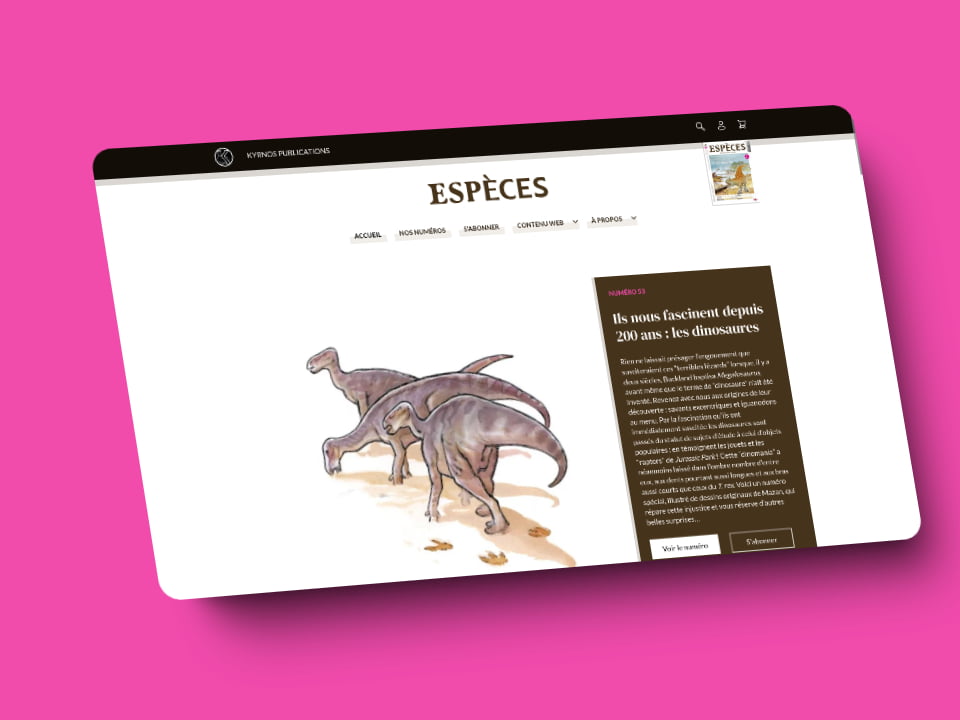Espèces
A complete overhaul, with the creation of an exhaustive index of the magazine's articles and an improved user experience.

What is Espèces ?
Espèces is a popular science magazine for the natural sciences that has been around since 2011.
Its aim is to ‘bridge the gap between specialist scientific publications and mass-market magazines by working as closely as possible to the very source of the information, i.e. the world of research’.
With over fifty quarterly publications since its inception, Espèces has carved out a place for itself in the sphere of French-language naturalist magazines.
Translated with DeepL.com (free version)
Why a revamp ?
It all began when the site was hacked in the spring of 2024.
Overnight, the site was transformed into a blank page with a simple form linking to another site.
A fairly standard hack, but one that had a major impact on the magazine, blocking access to digital content for its readership and causing it to lose new revenue every day.
Restoring and securing the site has enabled us to understand how this could have happened:
- poor server maintenance
- some extensions had not been updated for months
- poor monitoring and an overly fragile backup policy
Analysis of the site also revealed the complexity of managing its content and architecture.
Other issues were long overdue, such as the difficulty encountered by readers in comfortably reading their magazine in digital format.
Once the site was back online, we decided to go ahead with a complete overhaul based on sound, solid foundations.
Functionalities and objectives achieved
Redesigning a site is an opportunity to rethink and optimise everything.
So we took the opportunity to review the following aspects:
- a better structure for the site map
- aesthetic changes to better match the look of the magazine (in particular by streamlining the colour palette)
- functionality requirements and task automation
Creating a filterable index
A major addition to Espèces was the index. Since its publication, more than 700 articles had appeared in the paper magazine. We digitised this index on the website and put in place multiple filtering and search criteria to enable readers to quickly find in which issue and on which pages to find articles dealing with a certain theme.

Converting content to Gutenberg
The old Espèces website contained over a hundred editorials, articles and supplements built in a page builder.
This is very bad practice. A page builder is used to build… pages! Content that is dynamically rendered on a site, such as blog posts or author pages, should use the native WordPress editor so that it can be easily modified or transferred in the future.
Installation of an advanced PDF reader system
The old site already used a solution to enable subscribers to read issues online.
However, there were a number of complaints, not least because this solution was difficult to use on mobile devices.
A new professional system was used, which also made it possible to optimise display performance, create tables of contents and clickable links, and even secure access to files.

Easier, more granular management of member access
The magazine website needed a new system for managing the rights and access of each subscriber to the magazine. It had to take into account :
- the type of subscription (paper, digital, combined paper+digital) and its duration
- purchases of issues in digital format for online reading per issue
- creation of a dynamically created library for digital subscribers
- end-of-subscription reminder emails sent automatically to customers
A benchmark of solutions on the market was carried out to determine which best suited the magazine’s needs.
Implementation and data migration ensured a smooth transition to the new system.
Hundreds of new optimised pages
New types of dynamic content have been created, and linked together to create a better experience for website users.
All the new content has been optimised for search engine optimisation. In total, almost 1,500 pages were indexed in Google when the site went online, compared with just a few hundred on the original site.
Great care was taken to redirect old urls to new ones when page names had been changed.
The result in pictures
Performance analysis
The site is hosted on our servers and boasts excellent performance thanks to the advanced optimisations we’ve put in place: cache, CDN, next-generation image format, code optimisation, etc.

Very positive performance test carried out with the GTMetrix tool. Report available here.

Website Carbon carbon footprint test. Detailed audit available via this link.

Performance audit / Accessibility / Best practices / SEO via Page Speed Insight. Detailed audit available via this link.




